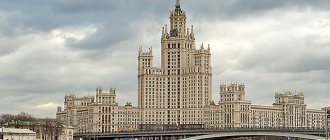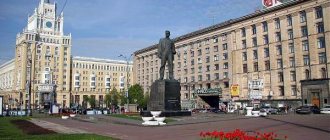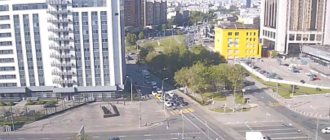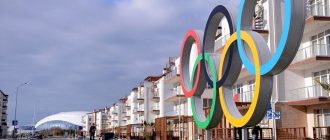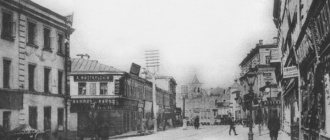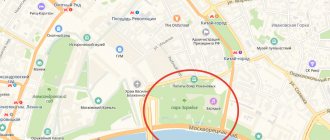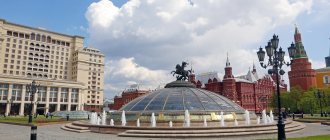If you have decided to move to Moscow or already live in Moscow, but are planning to move to another district, then you are undoubtedly thinking about which district of the city to choose. In this article we will briefly talk about the administrative districts of Moscow. Of course, we can talk about each of them for a very long time, and over time we will write separate articles about each district and district, their history and improvement. For now, we will limit ourselves to general information that will help you learn in general terms about the territorial division of Moscow. So let's get started!
Central Administrative District (CAO)
- area 66.17 km²; number of inhabitants - 775,881 people.
The Central District is located in Moscow[/anchor], its borders almost coincide with the territory of the city before 1912. There are government buildings here: ministries, the Kremlin, Government House, State Duma, Federation Council. The district is home to a large number of theaters, buildings, architectural and historical monuments.
The largest district of Moscow in the Central Administrative District is Presnensky, and the most densely populated is Arbat, with a population density of 16,838 people/km².
[edit] Comparison with similar data sets
[edit] Open data portal Moscow
Similar set: Borders of Moscow city districts (dial number 617)
Difference from this set (disadvantages):
- No geodata
- Duplicate records for multi-polygons: Vnukovo, Vostochny - as a result, the total number of objects is 129, which is more than the number of districts.
- Only areas of “old” Moscow
Note: At the time of last check (August 7, 2015), the set was removed from the open data portal. Its archived version can be found here.
[edit] Borders of the administrative-territorial division of the Russian Federation from OpenStreetMap
A similar set: Intra-city municipalities of Moscow and St. Petersburg.
Difference from this set (disadvantages):
- Only areas of “old” Moscow
- Titles are a mess
Northern Administrative District (NAO)
- area 113.72 km²; number of inhabitants - 1,176,611.
The Northern Administrative District is located in the north of Moscow and consists of 16 districts. On its territory there are 8 industrial zones, a river port and a river station, a railway and two federal highways M10 and E105. There are many sports facilities, including the Dynamo Stadium and the CSKA Arena.
The largest district of Moscow in the Northern Administrative District is Molzhaninovsky, occupying an area of 21.78 km², the most densely populated is Eastern Degunino at 1 sq. km. Home to 26,223 people. It is noteworthy that there is not a single metro station on the territory of Eastern Degunino.
North-Eastern Administrative District (NEAD)
- area 101.88 km²; number of inhabitants - 1,423,956.
NEAD itself is located in the north of the capital, and on its territory are the VDNKh pavilions, the Ostankino TV tower, and the Main Botanical Garden of the Russian Academy of Sciences. As well as such architectural and historical monuments as the Sheremetyev Estate, the Sviblovo Estate, the Memorial House-Museum of Academician S.P. Korolev and more. The district is traversed by branches of the Kaluzhsko-Rizhskaya, Serpukhovsko-Timiryazevskaya and Lyublinsko-Dmitrovskaya metro lines, the Moscow Monorail and the Moscow Central Circle railway line.
The largest district of Moscow in NEAD is Ostankino, it occupies 12.46 km², and the most densely populated district is Bibirevo, 1 sq. km. which is home to 24,814 people.
Eastern Administrative District (VAO)
- area 154.83 km²; number of inhabitants - 1,515,942.
The Eastern Administrative District consists of 16 districts, on the territory of which the Russian tsars organized hunting. Today it is one of the large districts of the capital, through which there are 4 metro lines: Sokolnicheskaya, Arbatsko-Pokrovskaya, Tagansko-Krasnopresnenskaya, Kalininskaya line and the route line of railway passenger transport. Among the attractions of the Eastern Administrative District are the Kuskovo and Izmailovo estates, sports institutions: Lokomotiv stadiums, Water Sports Center, etc. As well as large forested areas - Losiny Ostrov, Sokolnichesky and Izmailovsky parks.
The largest district of Moscow in the Eastern Administrative District is Metrogorodok, it occupies 27.56 km², and the most densely populated district is Novokosino, 1 sq. km. which is home to 29,901 people.
South-Eastern Administrative District (SEAD)
- area 117.56 km²; number of inhabitants - 1,405,650.
SEAD consists of 12 districts, which historically were working outskirts. That is why there is a large industrial zone here today, including enterprises such as the Moscow Oil Refinery, Moscow Mechanical, clothing factories, production of reinforced concrete structures, food industry and others. At the same time, there are many green areas in the district: Park named after the 850th anniversary of Moscow, Lefortovo and Lyublino pakri. Despite this, the South-Eastern Administrative District is considered one of the environmentally unfavorable districts of Moscow. This is facilitated by the capital's traditional western wind rose.
The largest district in the SEAD of Moscow is Pechatniki, which is located on 17.89 km² of land, and the most densely populated is Maryino with a population of 21,194 people/km².
Moscow settlements
Main article: Settlements of Moscow
Novomoskovsk administrative district:
- Voskresenskoye settlement
- Vnukovskoe settlement
- settlement Desyonovskoye
- Kokoshkino settlement
- settlement Marushkinskoye
- Moskovsky settlement
- settlement "Mosrentgen"
- settlement Ryazanovskoye
- Sosenskoye settlement
- settlement Filimonkovskoye
- Shcherbinka settlement
Trinity administrative district:
- settlement Voronovskoye
- Kyiv settlement
- settlement Klenovskoye
- Krasnopakhorskoe settlement
- Mikhailovo-Yartsevskoe settlement
- Novofedorovskoe settlement
- Pervomaiskoe settlement
- settlement Rogovskoye
- Troitsk settlement
- Shchapovskoye settlement
Southern Administrative District (SAD)
- territory 131.77 km²; number of inhabitants - 1,785,343.
The Southern Administrative District consists of 16 districts; on its territory there is a fairly extensive industrial zone with enterprises that arose at the beginning of the 17th century. In addition to industry and scientific centers, there are medical institutions, theaters, museums, concert halls and sports facilities: stadiums, swimming pools, one equestrian center and one ski resort. Six metro lines pass through the district: Zamoskvoretskaya, Kaluzhsk-Rizhskaya, Serpukhovsko-Timiryazevskaya, Lyublinsko-Dmitrovskaya, Kakhovskaya and Butovskaya, as well as the Moscow Central Ring Railway.
The most densely populated district of Moscow and, accordingly, in the Southern Administrative District is Zyablikovo, the population density is 30,390 people/km². The largest district in the southern administrative district is Eastern Eastern, occupying 14.77 km².
History of local government in Moscow
Local self-government was organized in Moscow in accordance with the resolution of the Presidium of the Supreme Soviet of the RSFSR dated July 1, 1991 “On the delimitation of the competence of government and management bodies in the city of Moscow.”
During this reform, the one-level system of dividing Moscow into districts was replaced by a two-level system: administrative and municipal districts.
Municipal districts
Municipal districts
- territorial units of local government that were formed in Moscow in 1991-1992. The first municipal districts were Brateevo and Krylatskoye[2]. They were formed in 1991 in accordance with the resolution of the Presidium of the Supreme Council of the RSFSR dated March 25, 1991 No. 953-I “On the proposal of the Moscow Council to create experimental municipal districts.”
A preliminary list of municipal districts preparing for the formation was published in the order of the Moscow Mayor dated July 5, 1991 No. 41-RM “On the work on the formation of municipal districts in Moscow”[3]. On August 1, 1991, a decree “On approval of the Temporary Regulations on governing bodies in the Moscow municipal district” was issued[4].
A little later, on September 12, 1991, the decree of the mayor of Moscow “On establishing temporary boundaries of the municipal districts of Moscow” was signed[5]. According to this order, the territory of Moscow was divided into administrative districts, which in turn were divided into 125 municipal districts[5]. At the same time, no municipal districts were created in the Central Administrative Okrug[2][4], it provided for the creation of territorial-sectoral city government bodies[6].
By Order of the Mayor of April 24, 1992 No. 106-RM, the Regulations on the municipal district (district) in Moscow were approved, in which the municipal district (district) was defined as the primary administrative-territorial unit of the city of Moscow[2]. The Regulations also stated that the boundaries of the municipal district (district) are established by the Mayor on the proposal of the prefect of the administrative district. Executive power in the municipal district was exercised by the sub-prefect
, who was actually the head of the municipal district[2].
After a series of boundary changes (see the table below for more details), by July 1995 the number of municipal districts was 121.
| History of changes in the boundaries of municipal districts and districts in 1991-2010 | ||||||
| Municipal districts | Districts | |||||
| 1991 preliminary list of planned districts[3] | 1991 districts created[5] | Changes | 1995 division into districts | 1995 created districts[7] | Changes | 2010 current division into districts[8] |
| Western administrative district | ||||||
| Krylatskoe | Krylatskoe | Krylatskoe | ||||
| Kuntsevo | Kuntsevo | Kuntsevo | ||||
| Mozhaisky (Southern Kuntsevo) | Mozhaisky (Southern Kuntsevo) | Mozhaisky | ||||
| Fili | Fili-Davydkovo | Fili-Davydkovo | ||||
| Matveevskoe-Davydkovo | ||||||
| Matveevskoe | Matveevskoe | merged 07/22/1997[9] | Ochakovo-Matveevskoe | |||
| Ochakovo | Ochakovo | Ochakovo | ||||
| Filevsky Park | Filevsky Park | Filevsky Park | ||||
| Olimpic village | Nikulino | merged 09/28/1993[10] | Troparevo-Nikulino | Troparevo-Nikulino | ||
| Nikulino | ||||||
| Troparevo | Troparevo | |||||
| Mosfilmovsky | Mosfilmovsky | Mosfilmovsky | merged 07/22/1997[9] | Ramenki | ||
| Ramenki | Ramenki | Ramenki | ||||
| Kutuzovsky | Kutuzovsky | merged 04/01/1994[11] | Dorogomilovsky | Dorogomilovo | ||
| Dorogomilovsky[12] | Dorogomilovsky | |||||
| Vernadsky Ave. | Vernadsky avenue | Vernadsky avenue | ||||
| Solntsevo | Solntsevo | Solntsevo | ||||
| Peredelkino | Novo-Peredelkino | Novo-Peredelkino | ||||
| —— | Vnukovo | Vnukovo | ||||
| Northwestern Administrative District | ||||||
| Northern Tushino | Northern Tushino | Northern Tushino | ||||
| South Tushino | South Tushino | South Tushino | ||||
| Pokrovskoye-Streshnevo | Pokrovskoye-Streshnevo | Pokrovskoye-Streshnevo | ||||
| Strogino | Strogino | Strogino | ||||
| Shchukino | Shchukino | Shchukino | ||||
| Khoroshevo-Mnevniki | Khoroshevo-Mnevniki | Khoroshevo-Mnevniki | ||||
| Mitino | Mitino | Mitino | ||||
| Kurkino | Kurkino | Kurkino | ||||
| Novo-Podrezkovo | Novo-Podrezkovo | went to Molzhaninovsky Northern District | ||||
| Northern Administrative District | ||||||
| Beskudnikovo | Beskudnikovsky | Beskudnikovsky | ||||
| Degunino | Eastern Degunino | Eastern Degunino | ||||
| Western Degunino | Western Degunino | merged 07/22/1997[9] | Western Degunino | |||
| Businovo | Businovo | Businovo | ||||
| Khovrino | Khovrino | Khovrino | ||||
| Golovinsky | Golovinsky | Golovinsky | ||||
| Levoberezhny ( including Molzhaninovsky ) | Levoberezhny | Divided 03/02/1992[13] | Levoberezhny | Levoberezhny | ||
| Molzhaninovsky | Molzhaninovsky | |||||
| Koptevo | Koptevo | Koptevo | ||||
| Voikovsky | Voikovsky | Voikovsky | ||||
| Falcon | Falcon | Falcon | ||||
| Khodynsky | Airport | Airport | ||||
| Khoroshevsky | Khoroshevsky | Khoroshevsky | ||||
| Running | Running | Running | ||||
| Savelovsky | Savelovsky | Savelovsky | ||||
| Dmitrovsky | Dmitrovsky | Dmitrovsky | ||||
| Nizhne-Likhoborsky | Timiryazevsky | Timiryazevsky | ||||
| North-Eastern Administrative District | ||||||
| Lianozovo | Lianozovo | Lianozovo | ||||
| Bibirevo | Bibirevo | Bibirevo | ||||
| Altufevsky | Altufevsky | Altufevsky | ||||
| Otradnoe | Otradnoe | Otradnoe | ||||
| South Medvedkovo | South Medvedkovo | South Medvedkovo | ||||
| Northern Medvedkovo | Northern Medvedkovo | Northern Medvedkovo | ||||
| Sviblovo | Sviblovo | Sviblovo | ||||
| Babushkinsky | Babushkinsky | Babushkinsky | ||||
| Losino-Ostrovsky | Losino-Ostrovsky | Losinoostrovsky | ||||
| Yaroslavsky | Yaroslavsky | Yaroslavsky | ||||
| Butyrsky | Butyrsky | Butyrsky | ||||
| Marfino | Marfino | Marfino | ||||
| —- | Marina Grove | Marina Grove | ||||
| Sheremetyevsky | Sheremetyevsky | |||||
| Rostokino | Rostokino | Rostokino | ||||
| Alekseevsky | Alekseevsky | Alekseevsky | ||||
| Ostankino | Ostankino | Ostankino | TEOS "Sheremetyevsky" was established on December 17, 1998[14] joined on December 4, 2002[15][16] | Ostankino | ||
| Northern | Northern | Northern | ||||
| Eastern administrative district | ||||||
| Perovo | Perovo | Perovo | ||||
| Novo-Gireevo | Novogireevo | Novogireevo | ||||
| Ivanovskoye ( including South Izmailovo ) | Ivanovskoe | m.o. Yuzhnoye Izmailovo formed 12/16/1991[17] abolished 12/22/1994[18] | Ivanovskoe | Ivanovskoe | ||
| Veshnyaki | Veshnyaki | Veshnyaki | ||||
| Vladykino[19] | went to Veshnyaki | —- | ||||
| Falcon Hill | Falcon Hill | Falcon Hill | ||||
| Chernichovo[20] | Cherkizovo | Preobrazhenskoe | ||||
| Sokolniki | Sokolniki | Sokolniki | ||||
| Bogorodskoye | Bogorodskoye | Bogorodskoye | ||||
| Open Highway | Open Highway | Metrotown | ||||
| Golyanovo | Golyanovo | Golyanovo | ||||
| Izmailovo | Eastern Izmailovo | Eastern Izmailovo | ||||
| Izmailovo | Izmailovo | |||||
| Northern Izmailovo | Northern Izmailovo | |||||
| Kosino | Kosino | Kosino-Ukhtomsky | ||||
| Ukhtomsky | ||||||
| —- | Novokosino | Novokosino | ||||
| —- | Oriental | Oriental | ||||
| South-Eastern Administrative District | ||||||
| Kapotnya | Kapotnya | Kapotnya | ||||
| Maryino | Maryino | Maryino | ||||
| Lyublino | Lyublino | Lyublino | ||||
| Printers | Printers | Printers | ||||
| Textile workers | Textile workers | Textile workers | ||||
| Kuzminki | Kuzminki | Kuzminki | ||||
| Ryazan Avenue | Ryazansky | Ryazansky | ||||
| Vykhino | Vykhino | Vykhino-Zhulebino | ||||
| Zhulebino ( including Nekrasovka ) | Zhulebino | Divided 03/13/1992[21] | Zhulebino | |||
| Nekrasovka | Nekrasovka | |||||
| Nizhny Novgorod | Nizhny Novgorod | Nizhny Novgorod | ||||
| —- | Yuzhnoportovy | Yuzhnoportovy | ||||
| Rogozhsky | —- | —- | ||||
| Hospital | —- | —— | ||||
| Lefortovo[12] | Lefortovo | Lefortovo | ||||
| Southern Administrative District | ||||||
| Orekhovo-Borisovo Western Orekhovo-Borisovo Eastern | Orekhovo-Borisovo Northern | Orekhovo-Borisovo Northern | ||||
| Orekhovo-Borisovo Yuzhnoye | Orekhovo-Borisovo Yuzhnoye | |||||
| Zyablikovo | Zyablikovo | Zyablikovo | ||||
| Brateevo | Brateevo | Brateevo | ||||
| Biryulyovo Western | Biryulyovo Western | Biryulyovo Western | ||||
| Biryulyovo East | Biryulyovo East | Biryulyovo East | ||||
| Lenino | Tsaritsyno | Tsaritsyno | ||||
| Moskvorechye-Saburovo | Moskvorechye-Saburovo | Moskvorechye-Saburovo | ||||
| Nagatino-Sadovniki | Nagatino-Sadovniki | Nagatino-Sadovniki | ||||
| Nagatinsky Zaton | Nagatinsky Zaton | Nagatinsky Zaton | ||||
| Chertanovo North | Chertanovo North | Chertanovo North | ||||
| Chertanovo Central | Chertanovo Central | Chertanovo Central | ||||
| Chertanovo Yuzhnoe | Chertanovo Yuzhnoe | Chertanovo Yuzhnoe | ||||
| Nagornoye | Nagornoye | Upland | ||||
| Simonovskoe | Simonovsky | merged 05/24/1995[22] | Danilovsky | Danilovsky | ||
| —- | Paveletsky | |||||
| Danilovsky | Danilovsky | |||||
| Donskoy[23] | Donskoy | merged 05/24/1995[22] | Donskoy | Donskoy | ||
| —- | Country | |||||
| Southwestern Administrative District | ||||||
| Yasenevo | Yasenevo | Yasenevo | ||||
| Teply Stan | Teply Stan | Teply Stan | ||||
| Konkovo-Verevkino | Konkovo-Derevlevo | Konkovo | ||||
| Lomonosovsky | Lomonosovsky | Lomonosovsky | ||||
| Gagarinsky | Gagarinsky | Gagarinsky | ||||
| Zyuzino | Zyuzino | Zyuzino | ||||
| Cheryomushki | Cheryomushki | Cheryomushki | ||||
| Academic | Academic | Academic | ||||
| Kotlovka | Kotlovka | Kotlovka | ||||
| Northern Butovo | Northern Butovo | Northern Butovo | ||||
| South Butovo | South Butovo | South Butovo | ||||
| —- | Obruchevsky | Obruchevsky | ||||
| Zelenograd administrative district | ||||||
| —- | Municipal district No. 1 | District No. 1 | merged into Matushkino-Savelki on December 4, 2002[15] separated from January 1, 2010[24] | Matushkino | ||
| —- | Municipal District No. 2 | District No. 2 | Savelki | |||
| —- | Municipal District No. 3 | District No. 3 | merged into Panfilovsky district on December 4, 2002[25] separated from January 1, 2010[24] | Old Kryukovo | ||
| —- | Municipal District No. 4 | District No. 4 | Silino | |||
| —- | Kryukovo | Kryukovo | ||||
| Central Administrative District | ||||||
| Zamoskvorechye | Municipal districts were not created in the Central Administrative District. Territorial administrations were created [26], for example * Territorial administration of Kitai-Gorod was created on 10/18/1991[27] * Territorial administration of Arbat was created on 03/31/1993[28] | Zamoskvorechye | ||||
| Yakimanka | ||||||
| Khamovnichesky | Khamovniki | |||||
| Presnensky | Presnensky | |||||
| Tverskaya | Tverskaya | TEOS "China-Gorod" was created on April 10, 1996[29] | Tverskaya | |||
| Meshchansky | Meshchansky | |||||
| Krasnoselsky | Krasnoselsky | |||||
| Basmanny | Basmanny | |||||
| Tagansky | Tagansky | |||||
| Gravity | —- | |||||
| —- | Arbat | |||||
Dividing the city into districts
On July 5, 1995, the law “On the territorial division of the city of Moscow”[7] was adopted, in which municipal districts were replaced by districts. The law spoke of 10 administrative districts, which included 128 districts (including three villages with district rights - Vnukovo, Vostochny and Northern), as well as territorial units with a special status (TEOS)[7].
District councils were declared executive authorities in the regions
.
The district government carried out the functions of a local government body established by law on issues of local importance, with the exception of issues referred to by the legislation of the city of Moscow within the competence of city government bodies. It consisted of the District Assembly
,
the administration of the Uprava
(district administration) and
the head of the Uprava
, who headed the district Assembly and the administration of the Uprava [2].
Law “On the organization of local self-government in the city of Moscow”
On November 6, 2002, Law No. 56 “On the organization of local government in the city of Moscow” was adopted. According to this law, Moscow was divided into municipalities
— territories within the boundaries of which local self-government is exercised[30].
By type, municipalities in Moscow belong to the intracity territory of a city of federal significance[31].
The territory and boundaries of intracity municipalities are determined by the law “On the names and boundaries of intracity municipalities in the city of Moscow”[32].
It is important that according to the 2002 law (unlike the 1992 provision), municipalities are not objects of administrative division, they are only created in a certain territory, which does not necessarily have to be tied to the administrative division.
In fact, the law “On the organization of local self-government in the city of Moscow” consolidated the duality of municipal (municipal entities) and territorial (districts) divisions in Moscow and delimited the powers of local government bodies. Municipal power (Council of Deputies and municipality) and administrative power (district government) operate in the same territory.
Changes in 2012
From 2002 to 2012, all municipalities of Moscow had the same powers. After the expansion of the territory of Moscow in 2012 and the inclusion of 21 new municipalities from the Moscow region, 3 types of municipalities appeared, the powers of which are slightly different[33]:
- municipal district
is a municipal entity created within the boundaries of the districts of “old” Moscow. All 125 municipalities that existed in Moscow before 2012 received municipal district status; - urban district
is a municipal entity that had the status of a city district within the Moscow region until July 1, 2012. This status was received by the Troitsk urban district and the Shcherbinka urban district; - settlement
- a municipal entity that had the status of “urban settlement” or “rural settlement” within the Moscow region before July 1, 2012. 19 municipalities received settlement status.
Thus, since 2012, the term “municipal district” has reappeared in Moscow legislation, but now not as an administrative-territorial unit, but as one of the types of municipalities.
Expanding the powers of local governments
In May 2012, Moscow Mayor Sergei Sobyanin stated that the powers of Moscow municipalities should be significantly expanded[34]. The mayor stated: “Responsibility for the situation in the area will now be divided between councils and local self-government 50/50.”[34].
In July 2012, Law No. 39 was adopted, according to which the powers of local governments in municipal districts (districts of “old” Moscow) were expanded from August 1, 2012[35].
Deputies of municipal assemblies of municipal districts will have the right to:
- annually hear reports from the head of the district government, the head of the government agency of the city of Moscow, the district engineering service, the head of the multifunctional center for the provision of public services, the head of the outpatient clinic of the municipal district, the head of the center for social services for the population of the municipal district[35][36]
- express no confidence in the head of the district government[35][36];
- coordinate an annual targeted list of courtyard areas for landscaping work, a list of apartment buildings for major repairs[35][36], and also monitor the progress of these works;
- coordinate the selection of land for the placement of garages and religious facilities[35][36];
- coordinate a draft urban development plan for a land plot for capital construction projects with an area of up to 1,500 m²[35][36];
- coordinate the draft layout of non-stationary retail facilities, as well as seasonal cafes[35][36];
It is important to separately note that this expansion of powers applies only to municipalities of “old” Moscow.
South-Western Administrative District (SWAD)
- territory 111.36 sq. km; inhabitants - 1,437,242.
South-Western Administrative District consists of 12 districts. The Great Moscow State Circus, RUDN University, Peoples' Friendship University of Russia, Russian National Research Medical University named after N.I. Pirogov and other institutions are located here. Almost one third of the territory is green areas: Bitsevsky Forest Park, Butovsky Forest, Vorontsovsky Park and Troparevsky Nature Reserve. Five metro lines pass through the circle: Sokolnicheskaya, Kaluzhsko-Rizhskaya, Serpukhovsko-Temiryazevskaya, Kakhovskaya (the shortest), Butovskaya and the MCC railway.
The most densely populated district of Moscow in the South-Western Administrative District is Lomonosovsky, with a population density of 26,366 people/km². The largest district in terms of territory is Yuzhnoye Butovo (25.53 sq. km), slightly inferior to Yasenevo with an area of 25.36 sq. km.
Western Administrative District (JSC)
- territory 153.03 sq. km; inhabitants - 1,382,516.
The closed joint-stock company consists of 12 districts, among which Ramenki is the largest, covering an area of 18.53 square meters, and Fili-Davydkovo is the most populated - population density 16,516 people/km². Five metro lines pass through the district: Sokolnicheskaya, Arbatsko-Pokrovskaya, Filevskaya, Koltsevaya and Solntsevskaya lines and the MCC railway. In addition to Orthodox churches, there is a synagogue and a mosque in the district. Among the higher educational institutions are the Institute of International Trade and Law, the All-Russian Academy of Foreign Trade and the M.V. Lomonosov Moscow State University. Among the parks are the Botanical Garden, Matveevsky Forest, and the Botanical Garden.
North-Western Administrative District (NWAD)
- territory 93.28 sq. km; inhabitants - 1,001,346.
North-Western Administrative District consists of 8 districts, one of which contains an experimental residential area (Kurkino). The district is one of the most ecologically clean, over 46% of the area is occupied by forests and park areas: the Kurkino Natural Park and the Skhodnya River Valley, an extensive forest strip in the north of the South Tushino district, Serebryany Bor Bottomless Lake and others. Two metro lines pass through the territory of the district: Tagansko-Krasnopresnenskaya and Arbatsko-Pokrovskaya lines.
The largest district in area is Khoroshevo-Mnevniki, occupying 17.81 sq. km, and the most densely populated is Northern Tushino, with more than 17,581 people living on one square kilometer.
Zelenograd Administrative District (ZelAO)
- territory 37.19 sq. km; residents - 243,084.
ZelAO is the first of 3 districts included in Moscow, completely located outside the Moscow Ring Road. This is the smallest administrative district of the capital. It consists of five districts, the most densely populated of which is Kryukovo, whose population density is 9,318 people/km². Research and production centers for electronics and microelectronics are located on the territory of the district, and therefore it is unofficially called the “Russian Silicon Valley”.
You can get from ZelAO to greater Moscow by buses and along the Oktyabrskaya Railway.
[edit] Download data
Update on uploading OSM data from 06/13/2014
| Data | List | ESRI Shape | GeoJSON | CSV+VRT | KML |
| Administrative districts | list | 0.2 Mb | 0.5 Mb | 0.1 Mb | 0.5 Mb |
| Municipalities | list | 0.4 Mb | 1.0 Mb | 0.2 Mb | 1.0 Mb |
Novomoskovsk Administrative Okrug (NMAO)
- territory 361.4 sq. km; residents - 234,226.
NMAO was formed in 2012 as part of the capital expansion project. Consists of 11 districts. The most densely populated settlement in the district is Shcherbinka, whose population density is 6,777 people/km².
You can get to greater Moscow by bus or electric train. In 2016, a metro came to the territory. However, these are currently two stations “Rumyantsevo” and “Salaryevo” of the Sokolnicheskaya line. Construction continues.
Local authorities
Local government bodies in the municipality of Moscow are[1]:
- The Council of Deputies
of a municipal district/urban district/settlement is a representative body of local self-government (until July 1, 2012 - the Municipal Assembly[33]), - Administration of
a municipal district/city district/settlement—executive and administrative body (until July 1, 2012—Municipality[33]), - other local government bodies formed in accordance with the charter of the municipality.
Head of municipal formation - head
municipal district, urban district or settlement[33].
The structure of local government bodies, as well as the name of local government bodies and local government officials, the procedure for their election (appointment), competence, terms of office, accountability, issues of organization and activity are determined by the charters of municipalities in accordance with the Charter of the City of Moscow, the Law “On Organization local government..." and other laws of the city of Moscow[1].
Troitsky Administrative District (TAO)
- territory 1,084.3 sq. km; inhabitants - 124,671.
TAO is the most distant district from the center, annexed to the capital in 2012. Consists of 10 settlements. The territories of the TAO are vast and not numerous, the most densely populated area is Troitsk, the density is 2,900 people/km², in the rest it does not exceed 200 people.
The main highway is Kaluzhskoe Highway, residents of the western part of the district use Kievskoe Highway. You can also get to greater Moscow by the Kyiv direction railway.
Moscow districts are 146 territories that are completely different from each other, but at the same time form a single, diverse image of the capital. This is the Tverskoy district of Moscow with the Kremlin, Red Square and the new Zaryadye Park. These are the Tretyakov Gallery in the Yakimanka area and the Moscow International House of Music on Bolotny Island.
And if you move away from the center, you can get into the residential (relatively residential) districts of Moscow: Yasenevo, Teply Stan, Biryulyovo, Butovo, Maryino, Tushino or Mitino... Each district has its own atmosphere and architecture. Blue high-rise buildings of the I-700A series in Yasenevo, duplexes in Kuntsevo, five-story buildings in Begovoy or merchant houses in Arbat. And Moscow also has its own villages, and these are not recently annexed districts, these are unique places that have remained untouched to this day. For example, an island surrounded by the Moscow River in the Khoroshevo-Mnevniki region. Thanks to the huge territory of the capital, no matter how long you live there, you can always discover something new.
*statistics in the article are as of January 1, 2018.
Notes
- ↑ 1 2 3 4
Law of November 6, 2002 No. 56 “On the organization of local government in the city of Moscow” (
Text of the legal act with amendments and additions as of November 1, 2014
). Portal Business Moscow. Retrieved October 29, 2014. Archived April 17, 2012. - ↑ 1 2 3 4 5 Sergey Borodin.
From the mayor to the municipality: on the fifteenth anniversary of the formation of new executive authorities in Moscow // My Moscow // Category: City and Power. - 2007. - No. 1. Archived on December 5, 2010. - ↑ 12
Order of the Mayor of Moscow dated July 5, 1991 No. 41-RM “On carrying out work on the formation of municipal districts in Moscow” - ↑ 12
Order of the Mayor of Moscow dated August 1, 1991 No. 75-RM “On approval of the Temporary Regulations on governing bodies in the Moscow municipal district” - ↑ 1 2 3
Order of the Mayor of Moscow dated September 12, 1991 No. 146-RM “On establishing temporary boundaries of municipal districts of Moscow” (
with amendments and additions dated December 16, 1991, March 2, 1992, September 28, 1993, April 1, December 22, 1994
) - Order of the Mayor of Moscow dated August 9, 1991 No. 81-RM “On governing bodies of the Central Administrative District of Moscow”
- ↑ 1 2 3
Law No. 13-47 of July 5, 1995 “On the territorial division of the city of Moscow” (
as amended on July 5, 1995
) - Law No. 13-47 of July 5, 1995 “On the territorial division of the city of Moscow” ( as amended on December 4, 2002
) with additions of
November 28, 2007
and
January 1, 2010 - ↑ 123
Decree of the Moscow government dated July 22, 1997 No. 550 “On improving the system of territorial division of the city of Moscow” Archived copy dated May 12, 2013 on the Wayback Machine, which was followed by corresponding changes to the law “On the territorial division of the city of Moscow” - the Law “On Amendments” ..." No. 32 of July 16, 1997 - Order of the Mayor of Moscow dated September 28, 1993 No. 535-RM
- Order of the Mayor of Moscow dated April 1, 1994 No. 154-RM “On the merger of the municipal districts Kutuzovsky and Dorogomilovsky”
- ↑ 12
Initially planned in the Central District - Order of the Mayor of March 2, 1992 No. 58-RM “On the formation of the Molzhaninovsky municipal district” (inaccessible link - history
). Retrieved January 2, 2012. Archived May 13, 2013. - Order of December 17, 1998 No. 1265-RM “On the formation of a territorial unit with a special status “Sheremetyevsky” and financing of TEOS”
- ↑ 12
Resolution No. 61 of December 4, 2002 “On Amendments to the Moscow City Law of July 5, 1995 No. 13-47 “On the Territorial Division of the City of Moscow”” - All-Moscow classifier of territorial units of Moscow. Ostankino district
- Order of the Mayor of Moscow dated December 16, 1991 No. 251-RM “On the formation of the municipal district “Southern Izmailovo””
- Order of the Mayor of Moscow dated December 22, 1994 No. 641-RM “On the merger of the municipal districts “Southern Izmailovo” and “Ivanovskoye””
- Probably means Vladychino
- Probably means Cherkizovo
- Order of the Mayor of March 13, 1992 No. 65-RM “On the formation of the municipal district “Nekrasovka Village””
- ↑ 12
Order of the Mayor of Moscow No. 261-RM dated May 24, 1995 “On the merger of the municipal districts “Danilovsky”, “Simonovsky”, “Paveletsky”, “Donskoy” and “Zagorodny” of the Southern Administrative District” - Initially planned in the South-Western District
- ↑ 12
Moscow City Law No. 26 of July 15, 2009 “On amendments to Article 4 of the Moscow City Law of July 5, 1995 No. 13-47 “On the territorial division of the city of Moscow”” - Moscow City Law of December 4, 2002 No. 61 “On amending the Moscow City Law of July 5, 1995 No. 13-47 “On the territorial division of the city of Moscow””
- Resolution “On territorial departments of the central administrative district of Moscow” (as amended on 04/11/96)
- Order of the Deputy Prime Minister of the Moscow Government of October 18, 1991 No. 565-RZP “On the formation of the administrative-territorial administration “China-Gorod””
- Order of the Mayor of Moscow dated March 31, 1993 No. 199-RM “On the territorial administration of the Arbat of the Central Administrative District of Moscow” ( as amended on April 11, 1996
) - Order No. 193-RM of April 10, 1996 “On the creation of a territorial unit with a special status in the Central Administrative District of Moscow”
- Charter of the city of Moscow. Revision as amended on June 1, 2011 ( unchanged on April 11, 2012
).
Chapter 9. “Organization of local government in the city of Moscow.”
Articles 54 - 59 . Official server of the Moscow City Duma. Retrieved April 18, 2012. Archived April 17, 2012. - Federal Law of October 6, 2003 No. 131-FZ “On the general principles of organizing local self-government in the Russian Federation”
- Moscow City Law “On the names and boundaries of intra-city municipalities in the city of Moscow” ( as amended on April 11, 2012
). Official server of the Moscow City Duma. Retrieved April 18, 2012. Archived April 17, 2012. - ↑ 1234
Law No. 8 “On amendments to the Moscow City Law of November 6, 2002 No. 56 “On the organization of local government in the city of Moscow.” Official portal of the Mayor and Government of Moscow (April 11, 2012). Retrieved April 17, 2012. Archived April 16, 2012. - ↑ 1 2 Alesya Lonskaya.
Deputies for small matters. Portal of the mayor and government of Moscow (July 26, 2012). Retrieved July 30, 2012. Archived July 29, 2012. - ↑ 1234567
Law No. 39 “On vesting local governments of municipal districts in the city of Moscow with certain powers of the city of Moscow.” Portal of the mayor and government of Moscow (July 11, 2012). Retrieved July 30, 2012. Archived July 29, 2012. - ↑ 1 2 3 4 5 6 Alesya Lonskaya.
Deputies for small matters. Russian reporter (July 26, 2012). Retrieved July 30, 2012. Archived July 29, 2012. - Law 11 “On amendments to the Moscow City Law of October 15, 2003 No. 59 “On the names and boundaries of intra-city municipalities in the city of Moscow.” Official portal of the Mayor and Government of Moscow (April 11, 2012). Retrieved April 17, 2012. Archived April 16, 2012.

